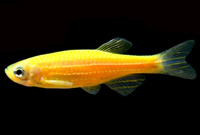

Jellyfish genes can be injected into a danio ebryo, and ‘plugged in’ to a part of the fish’s own DNA sequence. In 1992 the genes of this protein were sequenced and understood and further fluorescing genes were sought in organisms other then jellyfish.Įventually, it was possible to enhance the brightness and colours produced. The glowing mechanism is an important tool in understanding just what goes on inside a danio.įluorescing history had started in 1962 when Osamu Shimomura isolated glowing proteins in jellyfish. These are versatile fish, for sure, and a real reward for the aquarist prepared to go the extra mile and give them a biotope set-up. In the wild, habitats can vary anywhere from a pH of 5.1 with little hardness, to a much chalkier and more alkaline 8.2pH. Water chemistry variations are also shrugged off. Even larger ones can appear terrified of these unknown fish when in their presence. Unfortunately this is mistranslated as ‘goldfish compatible’ and young danios have been eaten by goldies. rerio not only graces tropical tanks but also unheated, temperate tanks.
#GOLDFISH AND ZEBRA DANIOS SKIN#
That fireproof skin also doubles as a duvet, with Zebras found down at 6☌/42☏.

In their native range they have been found up to 39☌/102☏ and lab tests suggest they can exist briefly when the water is even hotter. They are the living equivalent of asbestos, adapting to temperatures that would frazzle a weaker individual. The Zebra danio thrives because of its incredible tolerance of conditions and temperature. With this in mind, biotope aficionados should be rubbing their hands with delight… sota, Ctenops nobilis, Dario dario, Badis, other Danio species, Devario species, and even Tetraodon cutcutia pufferfish. conchonius) are also found, as are small gourami, C. Oryzias rice fish and Aplocheilus panchax killifish are other typical finds where D. rerio is the Indian flying barb (Esomus danricus) which can compete for resources, as both species make their living by feeding on mosquito larvae and other aquatic insects. Other fry predators include dragonfly larvae.Ĭommonly found alongside D. There are some population controllers, mainly Spiny eels (Mastacembelus armatus) in particular, spending much time mopping up eggs and larval danios. Considering that they are close to snakeheads (Channa sp.), Needlefish (Xenetodon), Knifefish (Notopterus) and Mystus bleekeri, it seems odd that so many end up inside kingfishers and herons and not so much in other fish. rerio are predated in the wild but fish don’t seem to be the dominant consumers. They prefer turbid waters with limited visibility and lab tests have shown that they repeatedly favour areas in dark conditions, even when there’s food involved.ĭ. For a long time they were considered lowland inhabitants, but recent expeditions have found them at 1,800m/5,900’. Seasonally they make their way to temporary streams called nalas, the result of monsoon weather, to spawn. Any sluggish body with a heavily silted bottom, or sometimes gravel and cobbles, will become home. rerio inhabit slow moving water, typically in floodplains, oxbows, slow streams and established rice paddies, preferring an older paddy to a newer one. It seems to make sense to give a highly active fish plenty of current to swim against…

Restlessness is how wild danios evade being eaten and a trait often mistranslated as a requirement for fast water. We know captivity has altered their selective pressures, so that farmed Zebras will have a higher fecundity (ability to produce offspring) than wild fish, while the latter exhibit a far greater degree of predator avoidance and restlessness than captive ones. We know more about laboratory Danio rerio than wild strains. Zebra danios are astonishingly tolerant of a wide range of conditions, which is why it’s all the more remarkable that some people still manage to kill them. Most unanimously agree that such tailored variants are the tackiest of gimmicks – myself included.

Placed into the wrong aquariums, plunged alongside goldfish or genetically altered to make them more aesthetically pleasing. You can subscribe to it for $499/ £318 a year! Not only are there websites dedicated to tracking their wild strains, they’re the sole subjects of a peer-reviewed journal entitled Zebrafish. Yet through it all, this fish has managed to remain dapper. The danio has encouraged many into the hobby, graced community tanks the world over, saved human lives and even been sent into space by NASA to see how it swims in zero gravity.


 0 kommentar(er)
0 kommentar(er)
